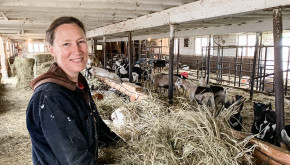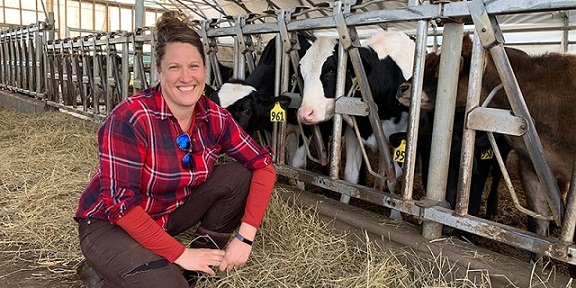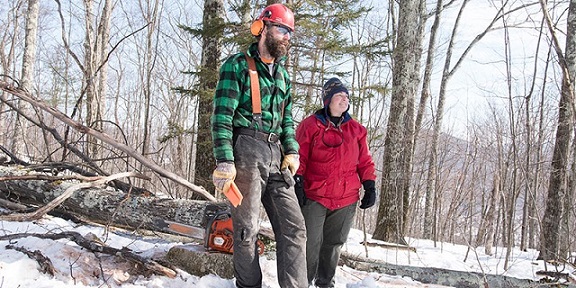
This article appeared in the Vermont Land Trust's Summer 2019 membership newsletter. The article can be found on the Vermont Land Trust's website at https://www.vlt.org/farms/women-farming-forestry. Story written by Sky Barsch.
It’s springtime after a long, snowy winter at Blue Ledge Farm in Leicester, and some of the roads in Addison County are flooded. A nearby farmer has bought the last spring doeling, but with roads underwater, she hadn’t been able to pick her up. Hannah Sessions, co-owner of Blue Ledge, scoops up the little gal and places her in the back of a truck. The trip is just one of Hannah’s many tasks as manager of a herd of 150 goats.
Together with her husband, Greg, Hannah runs their award-winning dairy on conserved land. Greg’s in charge of cheese-making, crop work, general repairs, and the books; Hannah oversees the herd, barn maintenance, marketing, and distribution. “I love making food for people,” Hannah says. “Part of what makes Vermont such a coveted place is its wealth of artisan and hand-crafted food, and it’s nice to be a part of that.” Hannah is among a growing number of women who are in leadership, ownership, and decision-making roles in farming and forestry in Vermont.
“Women have always been active on Vermont’s farms, but their contributions have not always been acknowledged,” says Mary Peabody, founding director of UVM’s Women’s Agricultural Network. “More women are taking on the role of principal, or primary, operator. They are starting and growing farms of their own, making the management decisions and doing the work required to sustain their farm businesses.”
Today, women make up over a third of the state’s primary agricultural producers. Trends indicate these numbers will continue to grow.
Hannah knew early on that she wanted to farm—she once returned from summer camp with a pair of sheep (her parents allowed them to stay). Hannah also wanted a career that would allow her time with her children. It’s been a demanding endeavor that, as Hannah says, “almost broke us on several occasions” (she was back in the barn three days after giving birth). But Blue Ledge has afforded her what she considers a trifecta: family, farming, and time for another passion, painting.
On a farm in southeastern Vermont, Abbie Corse came to farming in a different way. “I was not on track to be a farmer whatsoever,” she says. The sixth generation of her family to farm their Whitingham land, Abbie graduated from college and began a career in public relations and the arts. It was after a barn fire, when difficult decisions were on the table, that she came home to run Corse Farm Dairy.

“I just didn’t know how to imagine the land going into the hands of someone else,” she says. “It just broke my heart to think of driving on this road and not have some sort of pride of maintaining some stewardship.”
Like all farmers, Abbie works incredibly hard. But juggling career and family has been a challenge. “I’m an anomaly in that I don’t farm with my husband—he’s not a farmer.” Abbie says it’s been difficult to find quality, affordable daycare, and with her husband running a separate business, sharing childcare duty is not an option. Her family has been a huge support as she navigates the opportunities and challenges of farming, with her dad once remarking that children “are the most important crop.”
Abbie wants the challenges of farming to be talked about more, to encourage more support for farmers and for keeping land open. “People come to Vermont because it has these beautiful, huge forests and landscapes. That’s what Vermont is supposed to be,” she says.
On Vermont’s woodlands, too, women’s roles have been slowly expanding, something reflected in growing support networks for women forestland owners.
When Marli Rabinowitz bought 500 acres in Eden after inheriting some money, she was new to forest ownership. The land, with a magnificent pond, has provided Marli a refuge where she can connect with nature. But she had a lot to learn. “When I first bought the land, I was really excited; then it occurred to me that I had no idea what I was doing. Like I had bought an elephant and I had to figure out what it ate.”
Marli became active with Women Owning Woodlands, a national group with local chapters that build women’s forestry skills and knowledge. She’s now a board member of the Vermont Woodlands Association as well as the Windham Regional Woodlands Association. She says Women Owning Woodlands’ workshops feel different, though she’s careful to say not all women have the same experiences or goals. “I think it’s just one of those things [that] when you’re with women, you feel like you belong,” she adds. “You can talk and be heard, and you hear stories that are similar.”
Kathy Beland, a consulting forester in Rutland and Windsor counties, is just one of a handful of women among Vermont’s roughly 150 consulting foresters (just two of Vermont’s 14 county foresters are women). With so few women in her field, she recalls, it was a struggle to be taken seriously early in her career. These days she doesn’t see this much, though “every once in a while, you might run into someone,” she notes. “You just take a step back.”

Kathy spends a lot of time working with landowners to help them manage their land, such as addressing erosion problems or managing timber sales. “[Women] want to feel comfortable in the woods… It can be a little daunting if they don’t have a background in that.” Because it was more traditional that men were focused on the woods, the experience needed—such as identifying tree species or making decisions about logging—often haven’t been passed on to women. “It’s interesting to know [many private landowners] hire you because you’re a woman,” says Kathy. “I think it makes them more at ease.”
VLT’s Caitlin Cusack, a forester, visits dozens of forest-owning couples each year. Most of the time, the husband alone joins her on these annual walks and leads the management of the woods. In 2017 she attended a workshop by the Yale-based Sustaining Family Forest Initiative. “I was surprised to learn that landowner programming has not reached women at the same rate as men and that the challenges of land ownership are greater for women than men.”
According to the National Woodland Owner Survey (2013), women are primary owners of 475,000 acres (20%) of Vermont’s forestland. They co-own another 1.1 million acres (46%).
“Considering that women tend to outlive men and thus the final decision to sell or divide land is made more and more by women,” explains Caitlin, “it benefits us all to make sure they have all the information they need to make an informed decision. Vermont’s forests and farms are changing hands,” she adds. “Reaching out to women landowners and farmers is important, to continue our conservation work. We want to make sure that everyone has the knowledge and confidence to successfully manage their land.”
Be Heard: Sessions for Women Landowners
With support from the High Meadows Fund, VLT’s Caitlin Cusack is embarking on a year-long collaboration with several VLT partners, including Vermont Woodlands Association, Vermont Coverts, and UVM Extension. The groups will hold statewide listening sessions with women landowners to learn how women approach estate and succession planning, to hear more about gender-related gaps in confidence and knowledge about woodland stewardship, and to gather information about the differences in participation rates in forest landowner outreach and educational programs. For more information, you can subscribe for updates on the initiative by email.
Here are some additional resources:
American Farmland Trust’s Women for the Land
Women’s Agricultural Network
Women Owning Woodlands
Our Vermont Woods
This article appeared in the Vermont Land Trust's Summer 2019 membership newsletter. The article can be found on the Vermont Land Trust's website at https://www.vlt.org/farms/women-farming-forestry. Story written by Sky Barsch. Photos of Hannah Sessions and Abbie Corse by David Middleton, and photo of Kathy Beland courtesy of VSJF/Erica Houskeeper.

